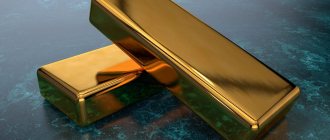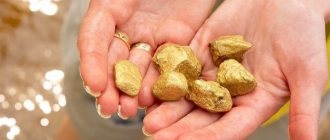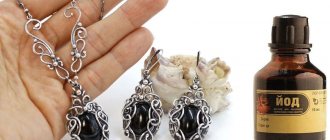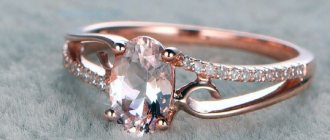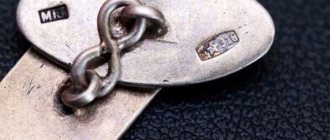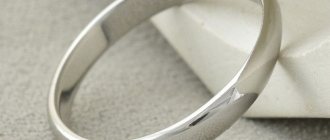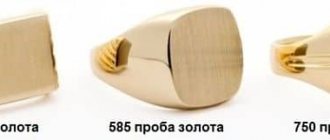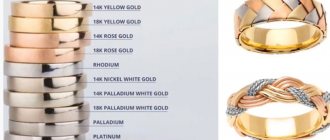Scrap gold is medium and small particles, placers, large nuggets or precious metal that remains in the washing trays as part of the ore after light particles of the rock have been removed. Gold miners extract it in its raw form, during washing of loose ore or specially prepared rocks. Gold concentrate can be contained in various forms, and after being found, in most cases it is subjected to processing - refining. After passing all the procedures in its pure processed form, the precious metal corresponds to the purity of 999. The price of spot gold is calculated taking into account the coefficient that corresponds to the percentage of precious metal content in the alloy. At the moment, in the second half of October 2021, the Central Bank of Russia estimates the cost of a gram at 4364 rubles.
Spot gold - what is it, definition and characteristics. Origin of the word "shlikh"
Scatter gold is medium or very small grains, scattering, large nuggets remaining in the washing trays as part of other elements after washing out the lightest particles. The noun “slich” itself is of Germanic origin and means “concentrate, sediment, precipitation.”
This type of precious metal contains a huge amount of impurities, but after all the necessary cleaning procedures it corresponds to 999 samples.
Grains of gold
All gold that has just been washed off the banks of rivers and has not undergone melting and refining is called schlich. The composition of the concentrate contains grains of minerals that are resistant to physical weathering.
Thus, gold-bearing raw materials are the simplest description of concentrate. It includes various rocks, stones, dust, sediment, that is, everything from which solar metal is obtained.
Characteristics of feedstock
For the study, a sample of “black concentrates” weighing 10 kg and a particle size of more than 93% class +0.1 mm was presented (the large fraction +1.0 mm was 21.2%; the fine fraction -0.05 mm - 2.3% ). The granulometric characteristics of the feedstock are given in Table 1.
| No. | Size class, mm | Class yield, % |
| 1 | 1 | 21,2 |
| 2 | -0,6 | 23,4 |
| 3 | -0,2 | 35,4 |
| 4 | -0,1 | 13,2 |
| 5 | -0,05 | 4,5 |
| 6 | -0,05 | 2,3 |
| 7 | Initial sample | 100 |
Table 1.
Granulometric composition of the “black concentrate” sample
Due to the presence of a large amount of +0.40 mm class with a total yield of 44.6% in the concentrate sample for research, part of the material was previously subjected to additional grinding in a ball mill to a particle size of 95% of -0.10 mm class.
X-ray phase analysis showed that the phase composition of the raw material is represented by the following minerals: magnetite (FeO Fe2O3) - 47.8%; quartzite (SiO2) - 32.9%; baddeleyite (ZrO2) - 14.0%; titanomagnetite (Fe2TiO4) - 4.56%. Of these, magnetite and titano-magnetite are predominantly bearing finely disseminated gold. The gold content in quartzite and baddeleyite is insignificant according to elemental analysis. The average gold content in the feedstock is 36.1 g/t; the gold content in the sample crushed to a particle size of -0.10 mm is 55.8 g/t.
Stages of the schlich method of gold mining
The spot method is rightfully considered the oldest method of searching for precious metals. In terms of popularity, it is not inferior to the dredge method. During the time when the gold rush was on the minds of people, the largest deposits of placer gold were discovered by washing concentrates of various rocks using ordinary washing pans, shovels, perseverance and, of course, luck.
The loose rock is processed either to a gray concentrate containing relatively light minerals, or to black, which is considered the final stage of washing. The final finishing of the material takes place in special trays.
There are several different versions of such trays - Korean, Siberian, Kharitonov and others. Most often, plastic and Korean trays are used for work. The raw material from which it is made affects the level of washing and extraction of concentrate. Geologists take this factor into account when analyzing the results of concentrate searches.
Influence of concentrate size on gold recovery
It is known that the most common reason for the technological resistance of gold ore raw materials is the thin dissemination of gold.
According to mineralogical analysis, finely dispersed gold in “black concentrates” is associated predominantly with iron oxides and hydroxides, which are products of the oxidation of gold-bearing pyrite. In this regard, to increase the efficiency of concentrate processing and the degree of gold recovery, a series of experiments were carried out on leaching samples of “black concentrate” of various sizes. It has been experimentally determined that optimal leaching results are achieved when 98% of the material is reduced to a level of -0.1 or -0.074 mm (200 mesh). Deeper grinding leads to an unjustified increase in energy consumption during grinding and greater difficulties in filtering and settling the pulps.
In relation to the specified maximum particle sizes of industrial suspensions, the processes of filtration and sedimentation of pulps proceed successfully when flocculants of the class of high-molecular polyamides are introduced into the system with a consumption of 5–6.5 g/t of solids. In this case, the process can be carried out in decanting mode, followed by filtration of the condensed product using vacuum suction filters, which is especially important for organizing production in “field” conditions.
Gold purification technologies (refining)
Extracting gold from concentrate is a painstaking process. It is called refining, and it is based on differences in the chemical and physical characteristics of metals.
When mining on an industrial scale, the precious metal is delivered to refineries in metal containers.
There are three refining technologies:
Electrolytic method
This technique is most beneficial for large production volumes and is most often used in large refineries. The method involves deposition of precious metals on an electrode and consists of two stages:
- Dissolving one of the electrodes in aqua regia or hydrochloric acid. Dissolution is accompanied by the application of current.
- Deposition of metals on the second electrode. Deposition is observed in layers, the first of which is the most precious metal.
For cleaning by electrolysis, it is required that the crude precious metal has a purity of at least 950. Then the procedure will allow you to obtain gold of maximum purity.
Refining - electrolytic method
Wet method
Recycling is accomplished by incorporating other metals to activate the process. The method may vary depending on the elements used.
Search method - reconnaissance, documents, washing.
To find a gold mine in our time, you will have to work hard; in the 21st century, all possible locations of gold have been studied and processed. And yet, the Ural region, the so-called “golden belt,” stores in its depths a considerable amount of precious metal. In our Sverdlovsk region, according to State Reserve documents, 232 deposits are registered with total reserves of categories A+B+C1 = 162,000 kg, C-2 = 128,000, and off-balance reserves 54,000 kg. The search method involves carrying out certain work.
Gold miners have to search for deposits in stages:
- study the geological structure of the deposit to take samples of loose sediments;
- draw up documents for production development;
- clear the area of top layer rocks;
- wash the concentrate sample with current documentation;
- wash control samples to determine the area of deposits;
Each stage of gold mining requires certain information, technologies and tools. From official historical sources it can be reliably stated that the first Russian mine began operating in 1747 in the city of Berezovsky. The impetus for the development of gold mining was a nugget found by Erofei Markov, a resident of the village of Shartash, the first mine was named Initial, followed by Listvennichny, Komarovsky, and Nebogaty. In 1754, the first gold mining plant was built in the city of Berezovsky and more than 50 mines were opened, producing large quantities of pure gold.
- Since 1805, more than 140 gold-bearing veins have been found in the mines and several dozen mining mines have come into operation. In the Urals, in the Sverdlovsk, Chelyabinsk and Tyumen regions, more than 70% of the mines operating at one time were located, and today about 20 tons are extracted from the subsoil of the Ural soil. Our Sverdlovsk region accounts for 11 tons of the total production.
The second point of work after determining the location of the search for gold metal is the preparation of permits and clearing of the soil from the rocks of the upper layer. Legal entities and individual entrepreneurs can engage in the development of gold deposits. The license for production is issued by the Federal body ROSNEDRA, which has offices in different regions of Russia; in the Sverdlovsk region, all issues related to minerals are resolved by the Ural Agency for Subsoil Use. Legal organizations receive licenses for a period of 20 years or more, private entrepreneurs can develop deposits without industrial volumes for a period of 5 years.
- Starting from 2021, private entrepreneurs have been introduced with additional rules that are mandatory. Mining is permitted by the surface method using hand tools, blasting, tractors and other equipment are prohibited, the mining depth is not less than 5 meters, people strictly specified in the contract can participate.
Site clearing is a process that has technological features, because it is advisable to carry it out at certain times of the year to reduce labor costs and the tools needed for work. The most suitable time of year for such work is the end of winter, when bushes and dead wood easily break down and the top layer of soil in peat areas is separated without complications. With a work plan thought out to the smallest detail, at the beginning of spring you can calmly begin working on the so-called balance sands and begin slurry washing.
Manual washing of rock is a responsible and labor-intensive task that requires certain skills and high-quality tools. Good work will make it possible to accurately determine the presence of gold metal and identify places with the highest concentration. Washing is carried out using wooden trays made of hardwood of various designs; the professional names of the trays are Oriental, Siberian, Korean.
The peculiarities of the options for obtaining heavy minerals make it possible to extract large grains from placers, mainly in the form of nuggets.
Metal sample after cleaning and its value on the stock market
After cleaning, the precious metal will correspond to the highest standard. Such a sample is designated by the number 999 in the metric system or by the sign “24K” in the karat system. According to the standard established by GOST, it contains 99.9% pure gold per gram of total mass.
The price for such metal is set by the Central Bank of the Russian Federation based on quotes from the London Stock Exchange.
Today, the current cost of the highest standard of gold varies on the stock market around 3800-4000 rubles per gram.
Reinforce the rosé
The first to begin to conjure gold, of course, was Rolex (by the way, the largest consumer of gold in the world, producing about 250,000 gold watches a year). Few Rolex wearers dared to leave their gold Oysters unattended on the beach when they went swimming, fortunately the case is waterproof. As a result, very soon the gold of the case and bracelet faded and even changed shade. It was then that Rolex came up with the material Everose, which is a patented gold alloy that does not lose tone when exposed to sea or chlorinated water. To make the alloy brighter, copper was added to it and the pink color was fixed with a fair amount of platinum. Everose was then certified as an 18k gold alloy. “Eternal Pink” is used in the Oyster Perpetual Day-Date, Lady-Datejust Pearlmaster, Cosmograph Daytona and Yacht-Master models of both generations. This year, the Yacht-Master I was released in Everose case diameters of 47 mm and 40 mm. This model debuted a new Oysterflex bracelet, combining the flexibility and comfort of rubber with the strength and reliability of metal.
Not long ago, Rolex invented another type of gold - Gold Crystals. Crystalline gold has a very unusual surface with transparent pyramids that shimmer intricately, refracting light. In the Rolex Oyster Perpetual Cosmograph Daytona, they cover the chronograph's 30-minute and 12-hour counters, as well as the seconds subdial.
How can you find out the cost of 24K today?
Information on the price of gold is published daily on the official website of Sberbank. Bank branches also have this information.
You can find out the cost by looking at the Internet exchange. Gold is referred to as "XAU". On the exchange you can monitor changes in quotes in real time.
It is worth considering that the price set by the Central Bank of the Russian Federation is only a guideline for jewelry stores and pawnshops. The cost of 24K may vary slightly depending on the region where the purchase or sale takes place.
Specks of gold
Washing cakes after leaching
The need to solve this problem is determined by the high cost of iodine, which requires its complete return to the technological cycle.
This is achieved by using a three-stage water washing of the cake after leaching of gold and iodine captured by the cake at a ratio of F:T = 1 (wt.) through repulpation operations and subsequent filtration. Already at the first stage of water washing, gold is almost completely washed away, after the third - iodine. Based on the above, a process scheme was developed for washing the leached cake from dissolved gold and chemical reagents: potassium iodide (KJ) and iodine (J2).
After the process of iodine-iodide leaching, the pulp is sent for filtration, the production gold-containing solution accumulates in a receiving tank and is sent for reagent gold precipitation with hydrazine.
The insoluble residue - cake (20% moisture content) - is sent to the 1st water wash. It is transferred to the second reactor, where it is pulped with water to a ratio of L:S = 1, and the resulting pulp is filtered. The 1st wash water is sent to the receiving tank, and the cake is sent sequentially first to the 2nd and then to the 3rd water wash, which are carried out in a similar way. After the completion of the 3rd water washing process, the wet cake, washed from gold and reagents (99.5%), is sent to the tailings dump, and the 3rd washing water can be disposed of or reused at the stage of the 1st water washing.
The remaining 1st and 2nd wash waters from this operation are combined in one container and sent to the sorption purification operation from iodine.
Category: questions and answers
Where are the searches for gold concentrate carried out?
Expert opinion
Shabanov Andrey
Amateur prospector, has been searching for gold for over 14 years
The main gold-bearing areas of Russia are located in the northern and northeastern regions: Magadan, Amur, Irkutsk regions, Khabarovsk, Primorsky, Transbaikal Territories. But small areas rich in precious metal are found everywhere. Gold concentrate is sought among rocks, soil and clay taken from the banks of rivers and streams. The precious metal ends up in the river itself after landslides or under the pressure of its own weight. When it is found in a river, gold miners go upstream, taking samples.
Is it possible to wash a nugget in schlich sand?
Expert opinion
Shabanov Andrey
Amateur prospector, has been searching for gold for over 14 years
Small nuggets can be washed in clay sand. The lower limit for a nugget is 0.3 grams of weight. Smaller precious metals are usually called gold flakes or particles.
Gold without impurities
Why is spot gold cheap?
Expert opinion
Pribrezhny Gennady Valentinovich
Jeweler 6th category
Indeed, schlich precious metal is one of the cheapest. It has not yet been purified and includes a considerable amount of impurities such as copper, silver, and iron. Therefore, it is of no value either to the jewelry industry or to industry. After undergoing refining procedures, the cost of pure gold will increase significantly and will correspond to the price of the highest standard at the rate of the Central Bank of the Russian Federation.
Sorption purification of wastewater from iodine
Research has shown that the requirements of the developed technology are fully met by the anion exchanger Purolite S992, whose iodine capacity is 0.916–0.970 g/g.
Experiments have shown that to saturate the resin, 12 hours of contact are required at a sorbent: solution volume ratio of 1:4000. The residual iodine content in the sorption mother liquor is 10–12 mg/l. Desorption of iodine from a saturated sorbent was carried out with a solution of the composition: NaOH (20 g/l) + sodium sulfite Na2SO3 (75 g/l) with a consumption of 10 volumes of desorbing solution per volume of resin. Commercial desorbate (4 volumes) is used to separate iodine and return it to the technological cycle; poor desorbing solutions (beginning and end of desorption) are used to prepare fresh desorbing solutions.
Royal miracle
Its own metallurgical plant so far only appears in the production plans of the Hublot house. But the metallurgical department and laboratory already exist. And they work very effectively. We have already mastered the production of two varieties of gold. Together with the Swiss Federal Institute of Technology in Lausanne, Magic Gold was invented - an amazing combination of pure 24-karat gold with ceramics. Molten gold of the highest purity (24 carats) is fed into the previously obtained porous ceramic substance under enormous pressure, and then watch cases are formed at the highest temperature and again under enormous pressure of inert gas. The resulting alloy has a nature very close to gold. Hublot even got it certified as 18-karat gold. But the great thing is that Magic Gold has a hardness of 1000 Vickers, three times that of steel.
Another achievement of Hublot metallurgists is called King Gold. It has a red tint due to the high copper content, which had to be compensated by adding 5% platinum. “Royal” gold is very bright, but not as durable as “magic” gold. Therefore, it is used in complex models not intended for everyday wear. This year it was used to make a 45mm perpetual calendar case with the Hublot Big Bang Chrono Perpetual Calendar chronograph.
Aloe and honey
The Italians love bright colors and for the sake of their brightest scarlet gold on the market, they increased the copper content to 24.1%. At this concentration, copper is already capable of decomposing gold and covering the alloy with a patina. Therefore, the Italians gave the remaining 0.9% to 950-carat platinum. The Panerai Radiomir 1940 10 Days GMT, presented last October, is made of scarlet gold and is based on a new in-house automatic movement with a ten-day power reserve.
The Germans are a calmer people and more reserved in their tastes, so for the A. Lange & Sohne 1815 “200th Anniversary FA Lange” model, an exclusive alloy called “honey gold” was developed, which has a shade of acacia honey. At the same time, honey gold is as hard as steel (300 Vickers, which is twice as hard as regular 18-karat gold). It's also not cheap, and until this year it was only used in complex Pour Le Merite models, of which several dozen were made. However, for a fairly simple model, an exception was made in honor of the 200th anniversary of the birth of the founder of the house, Ferdinand-Adolph Lange. However, the series is limited to 200 copies.
